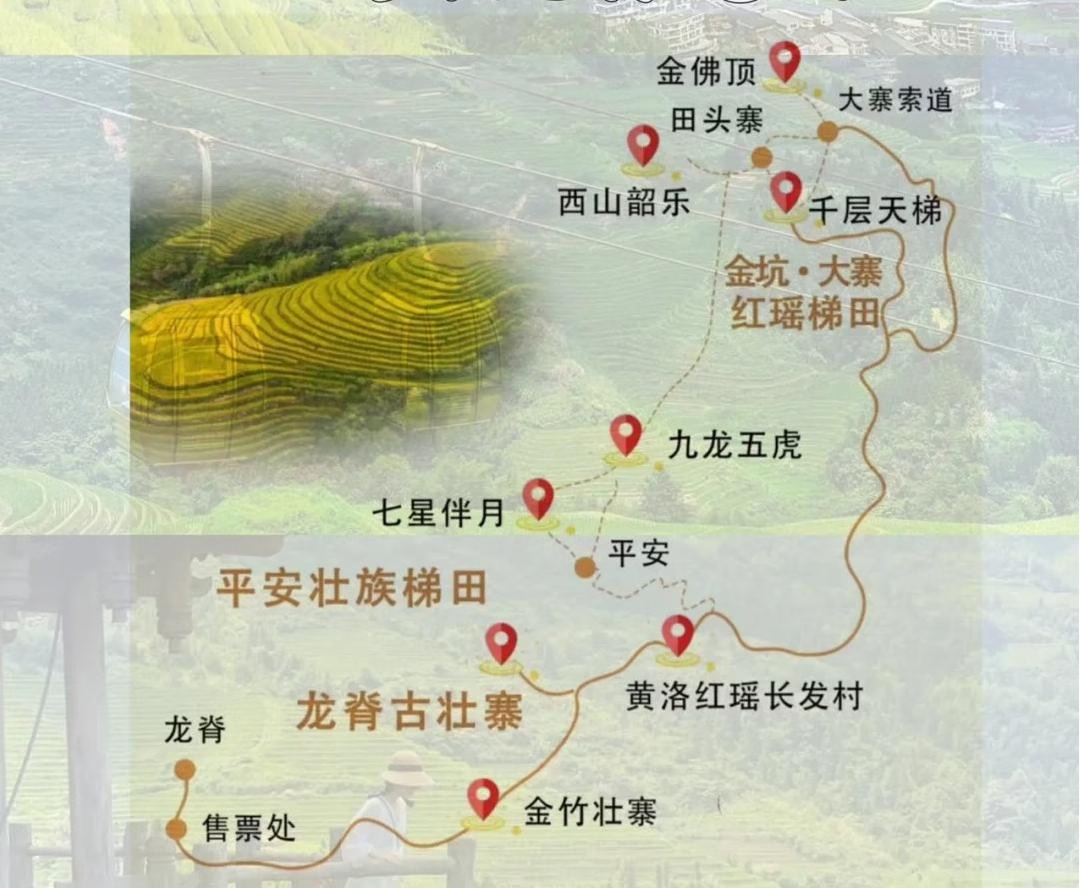Longji Rice Terraces, located in the picturesque hills of Longsheng, are a must-visit destination for nature lovers and photographers. The terraces are divided into three main scenic areas: Guzhuang Village (古壮寨), Ping’an Village (平安寨), and Jinkeng Dazhai (金坑大寨). Each offers unique landscapes and experiences. Whether you’re hiking, taking a sightseeing bus, or enjoying local cuisine, this guide will help you choose the best way to explore these magnificent terraces, how to stay, and what to eat while you’re there.

1. Guzhuang Village (古壮寨)
Scenic Highlights: Guzhuang is the smallest and most peaceful of the three areas. The village is known for its expansive terraces with gentle slopes and its traditional Zhuang-style wooden stilt houses, which are among the most well-preserved in China. This area is perfect for those looking for a quiet and authentic experience, away from the more crowded spots. The terraces are less developed compared to Ping’an and Jinkeng Dazhai, making it a great place to experience the original rural charm.
How to Explore Guzhuang Village:
- Hiking: There are several small trails leading through the terraces, connecting the lower, middle, and upper parts of the village. However, this walk can take 1 to 1.5 hours one-way and may be tiring for some visitors.
- Sightseeing Bus: The bus can take you directly to the Upper Village Viewing Platform for just 20 RMB per person, saving time and energy.
Best for:
- Travelers seeking a peaceful atmosphere and cultural heritage.
- Those interested in ancient architecture and less-crowded landscapes.
2. Ping’an Village (平安寨)
Scenic Highlights: Ping’an Village is the second-largest of the three areas and is famous for its compact and beautifully designed terraces. It is home to two iconic viewpoints: Jiulong Wuhu (九龙五虎) and Qixing Ban Yue (七星伴月), both of which offer spectacular views of the terraces, especially during sunrise and sunset. Ping’an is also the most developed area in terms of tourism, with a more commercialized atmosphere, but it remains a popular spot due to its photogenic landscapes and convenient access.
- Jiulong Wuhu: A famous viewpoint where you can see “Nine Dragons” and “Five Tigers.” The ridgelines appear like giant dragons stretching across the sky, creating a stunning sight.
- Qixing Ban Yue: A picturesque area where seven small terraces surround a large central one, resembling seven stars accompanied by the moon.
How to Explore Ping’an Village:
- Hiking: Exploring both Jiulong Wuhu and Qixing Ban Yue on foot will take approximately 2 hours and can be a bit physically demanding, especially in the heat.
- Sightseeing Bus: From the Ping’an village parking lot, you can take a sightseeing bus to the Jiulong Wuhu viewpoint for 30 RMB one-way or 50 RMB for a round trip.
Best for:
- Travelers who enjoy scenic views and don’t mind a more touristy atmosphere.
- Those interested in a mix of cultural experience and natural beauty.
3. Jinkeng Dazhai (金坑大寨)
Scenic Highlights: Jinkeng Dazhai is the largest and most spectacular area among the three, with the most extensive terraces and the most dramatic landscapes. The area features three primary viewpoints:
- Xishan Shaole Viewpoint (西山韶乐): Known for its incredible views of the terraces at sunrise and sunset. It’s the highest viewpoint in the area, offering panoramic views of the entire Jinkeng Dazhai rice terraces. It’s a 30-minute walk to reach this point.
- Qianceng Tianti Viewpoint (千层天梯): A stunning spot where the terraces resemble a giant staircase leading up to the sky. It’s perfect for photos, especially at sunset.
- Jinfo Ding Viewpoint (金佛顶): This is the most popular viewpoint for sunset views, with a cable car available to save time and energy. From Jinfo Ding, you can see the famous “Golden Hanging Gourd” and the surrounding terraces in full view.
How to Explore Jinkeng Dazhai:
- Hiking: To explore the entire area by foot, expect to spend at least 4+ hours hiking through the terraces. This is best for experienced hikers and those seeking a more immersive experience in nature.
- Cable Car: If you prefer a less strenuous visit, the cable car to Jinfo Ding is a convenient option. The cable car ride is 55 RMB one-way or 100 RMB for a round trip, and it saves a lot of time, allowing you to enjoy the panoramic views of the terraces without the physical strain.
Best for:
- Visitors who enjoy more expansive, breathtaking views and don’t mind a longer trek.
- Photographers looking to capture the grand scale of the rice terraces.
- Those who prefer a mix of adventure and convenience with the option of using the cable car.
Tips for Visiting Longji Rice Terraces
- Safety First: The terrain in Longji Rice Terraces can be quite steep and challenging. For those unfamiliar with mountain roads or hiking, it’s best to avoid driving yourself and opt for public transportation or a sightseeing bus.
- Ticketing: A single ticket gives access to all three areas (Guzhuang, Ping’an, and Jinkeng Dazhai), but be sure to keep your ticket safe as there are checkpoints between the areas where tickets may be checked.
- Best Time to Visit: The best times to visit Longji Rice Terraces are during the planting season (April to June) when the terraces are filled with water, creating reflective surfaces. The harvest season (September to October) is another fantastic time when the terraces turn golden.

